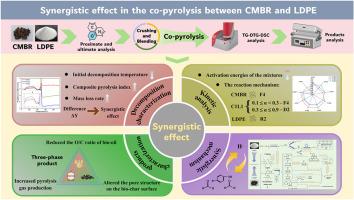Study on the synergistic effect in the co-pyrolysis between chicken manure biogas residue and low-density polyethylene
IF 5.8
2区 生物学
Q1 AGRICULTURAL ENGINEERING
引用次数: 0
Abstract
The synergistic effect in the co-pyrolysis between chicken manure biogas residue (CMBR) and low-density polyethylene (LDPE) was revealed. The weight loss and kinetics during co-pyrolysis were characterized using a synchronous thermal analyzer. The effects of mixing ratio and pyrolysis temperature on the characteristics of the three-phase products of co-pyrolysis were analyzed using a tube furnace. The results demonstrated an increase in mass loss rate (Mf) and comprehensive pyrolysis index (CPI) and a reduction in activation energy compared to theoretical calculations, confirming the presence of synergistic effect in the co-pyrolysis between the two materials. Positive synergistic effect was the most pronounced at the mixing ratio of 1:1. Co-pyrolysis inhibited bio-oil production and reduced the O/C ratio of bio-oil; it also precipitated the release of pyrolysis gas and increased the yields of CH4 and hydrocarbon gas (CnHm). Co-pyrolysis reduced the content of nitrogenated organic compounds in bio-char, enhanced its aromaticity and altered the pore structure on the bio-char surface. At higher pyrolysis temperatures, co-pyrolysis bio-oil further transformed into small-molecule gases, leading to an increase in the yields of CO and H2.

鸡粪沼气渣与低密度聚乙烯共热解协同效应研究
揭示了鸡粪沼气渣(CMBR)与低密度聚乙烯(LDPE)共热解的协同效应。用同步热分析仪对共热解过程的失重和动力学进行了表征。在管式炉上分析了混合比和热解温度对共热解三相产物特性的影响。结果表明,与理论计算相比,两种材料的失重速率(Mf)和综合热解指数(CPI)增加,活化能降低,证实了两种材料在共热解过程中存在协同效应。混合比为1:1时,正协同效应最为显著。共热解抑制生物油的生成,降低生物油的O/C比;促进热解气体的释放,增加CH4和碳氢气体(CnHm)的产率。共热解降低了生物炭中含氮有机物的含量,增强了生物炭的芳香性,改变了生物炭表面的孔隙结构。在较高的热解温度下,共热解生物油进一步转化为小分子气体,导致CO和H2的产率增加。
本文章由计算机程序翻译,如有差异,请以英文原文为准。
求助全文
约1分钟内获得全文
求助全文
来源期刊

Biomass & Bioenergy
工程技术-能源与燃料
CiteScore
11.50
自引率
3.30%
发文量
258
审稿时长
60 days
期刊介绍:
Biomass & Bioenergy is an international journal publishing original research papers and short communications, review articles and case studies on biological resources, chemical and biological processes, and biomass products for new renewable sources of energy and materials.
The scope of the journal extends to the environmental, management and economic aspects of biomass and bioenergy.
Key areas covered by the journal:
• Biomass: sources, energy crop production processes, genetic improvements, composition. Please note that research on these biomass subjects must be linked directly to bioenergy generation.
• Biological Residues: residues/rests from agricultural production, forestry and plantations (palm, sugar etc), processing industries, and municipal sources (MSW). Papers on the use of biomass residues through innovative processes/technological novelty and/or consideration of feedstock/system sustainability (or unsustainability) are welcomed. However waste treatment processes and pollution control or mitigation which are only tangentially related to bioenergy are not in the scope of the journal, as they are more suited to publications in the environmental arena. Papers that describe conventional waste streams (ie well described in existing literature) that do not empirically address ''new'' added value from the process are not suitable for submission to the journal.
• Bioenergy Processes: fermentations, thermochemical conversions, liquid and gaseous fuels, and petrochemical substitutes
• Bioenergy Utilization: direct combustion, gasification, electricity production, chemical processes, and by-product remediation
• Biomass and the Environment: carbon cycle, the net energy efficiency of bioenergy systems, assessment of sustainability, and biodiversity issues.
 求助内容:
求助内容: 应助结果提醒方式:
应助结果提醒方式:


